Abstract
Dogs are well established as experimental animals for the study of both renal disease and hypertension, but most work is based on surgical or pharmacological models and relatively little on spontaneous diseases. This review argues for the latter as an underexploited aspect of comparative medicine. The most important feature of canine hypertension may not be the ease with which models can be produced but the fact that dogs are actually rather resistant to hypertension, and perhaps to its effects, even when they have chronic renal failure. The importance of natural models of chronic renal failure is strengthened by the evidence that self-sustaining progression is a consequence of extreme nephron loss, that is, a late event, rather than the dominant feature of the course of the disease. The role of salt in hypertension is discussed and emphasis given to the importance of understanding the physiological basis of nutritional requirement and recognizing that it is unlikely to exceed 0.6 mmol/kg/day for most healthy adult mammals except during pregnancy or lactation. Such a perspective is essential to the evaluation of experiments, whether in animals or humans, in order to avoid arbitrary definitions of 'high' or 'low' sodium intake, and the serious misinterpretations of data which result. An age-related rise in arterial pressure may well be a warning of excess salt intake, rather than a normal occurrence. Problems of defining hypertension in the face of variability of arterial pressure are also discussed.
Full text
PDF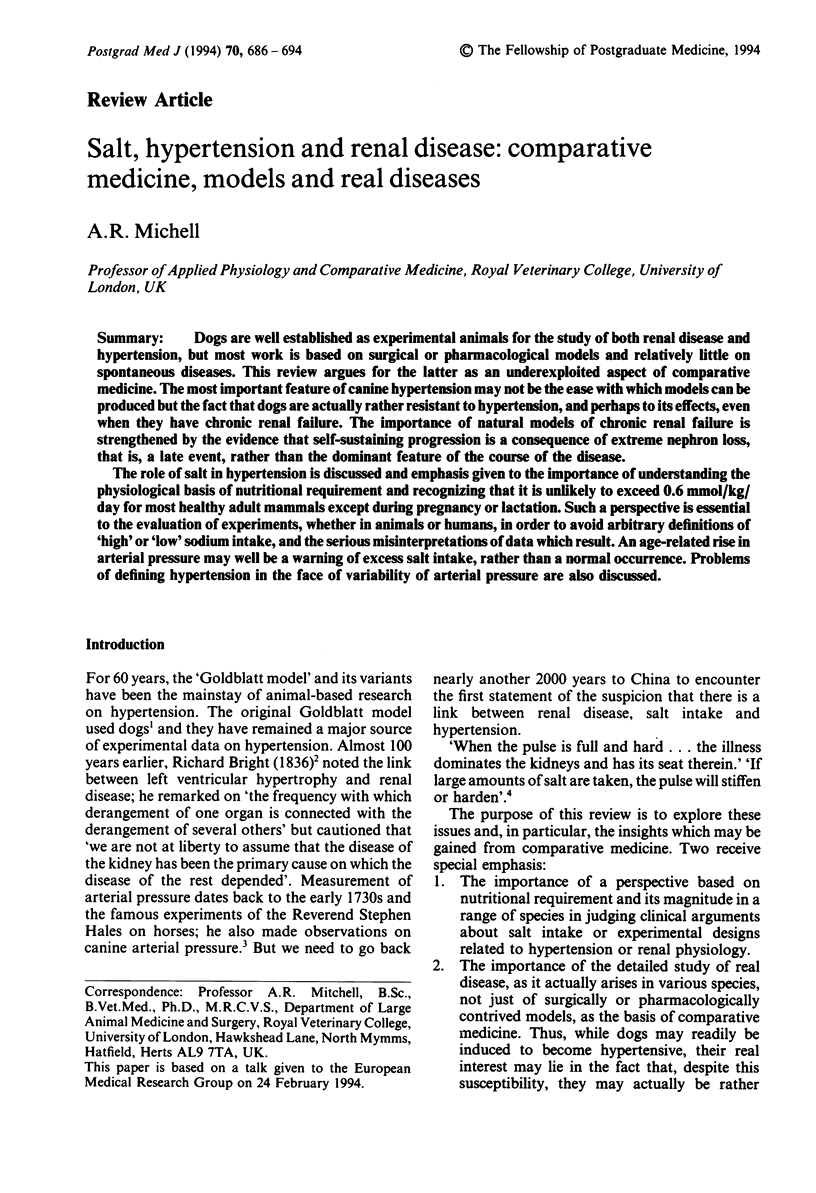
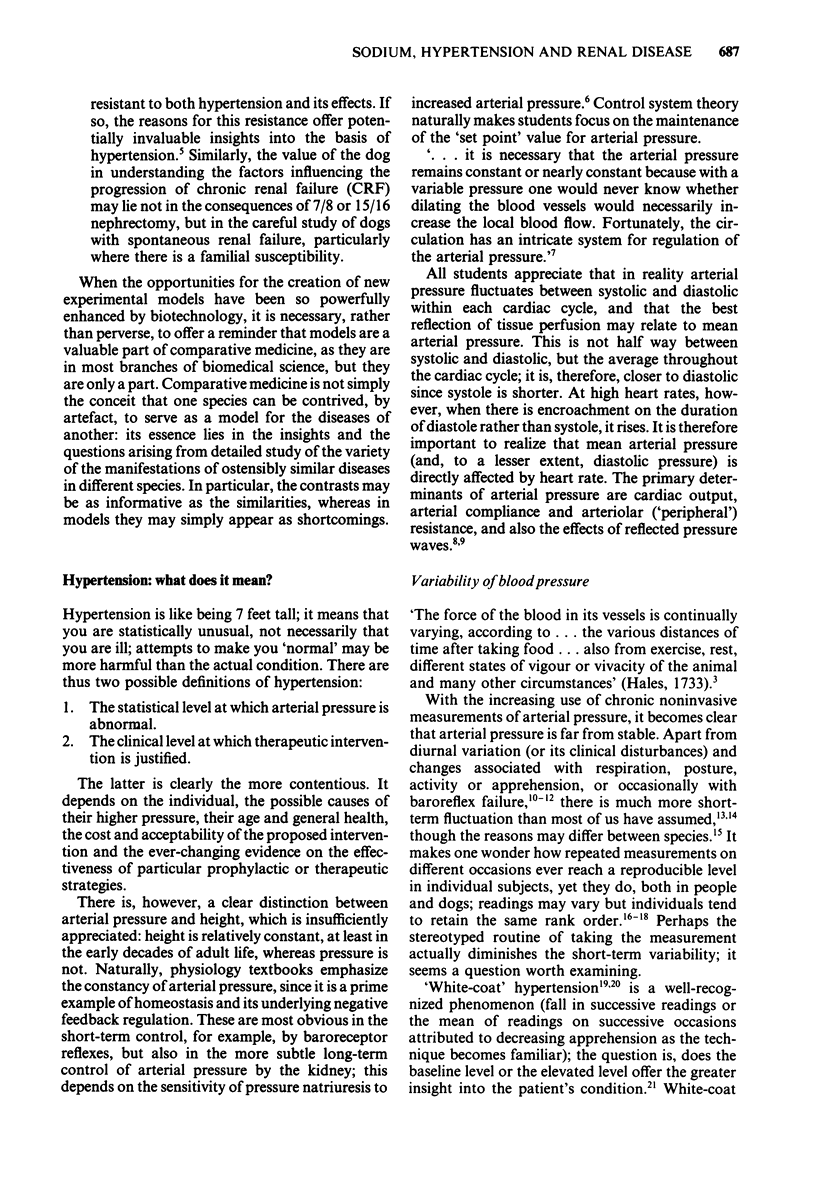
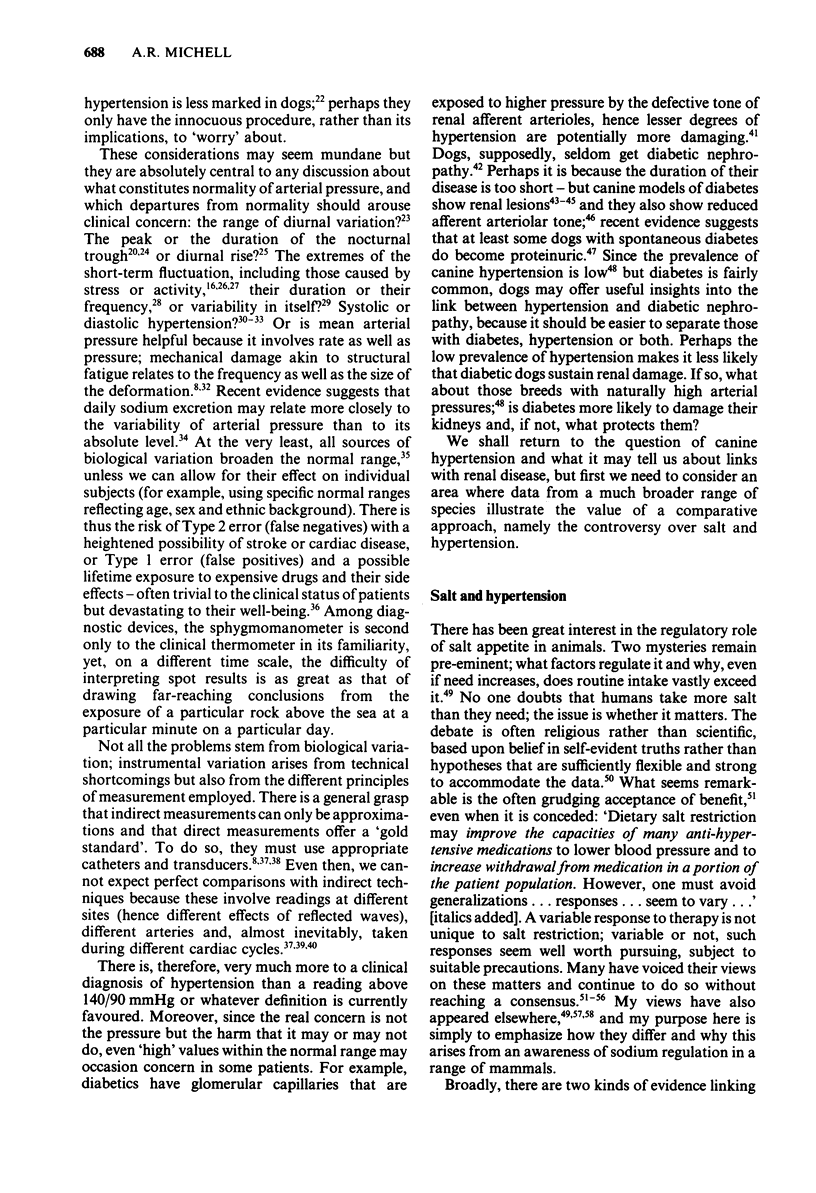
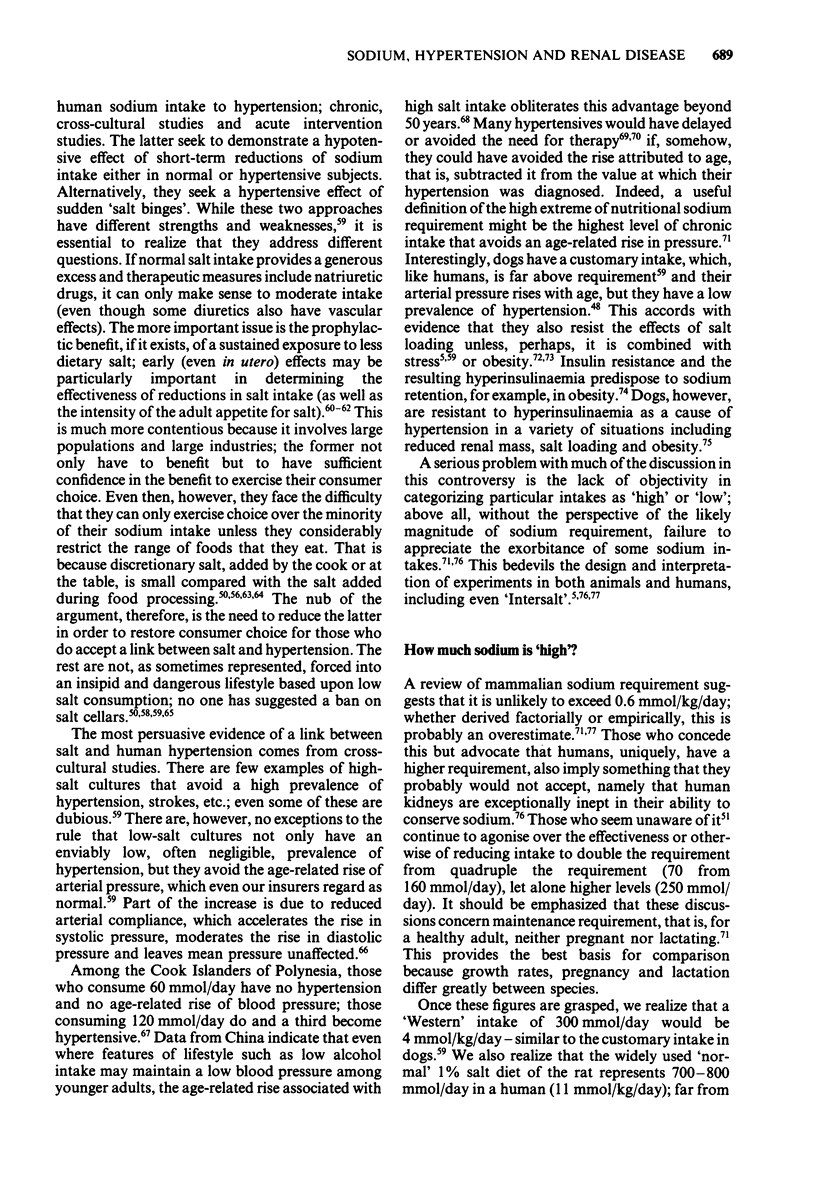
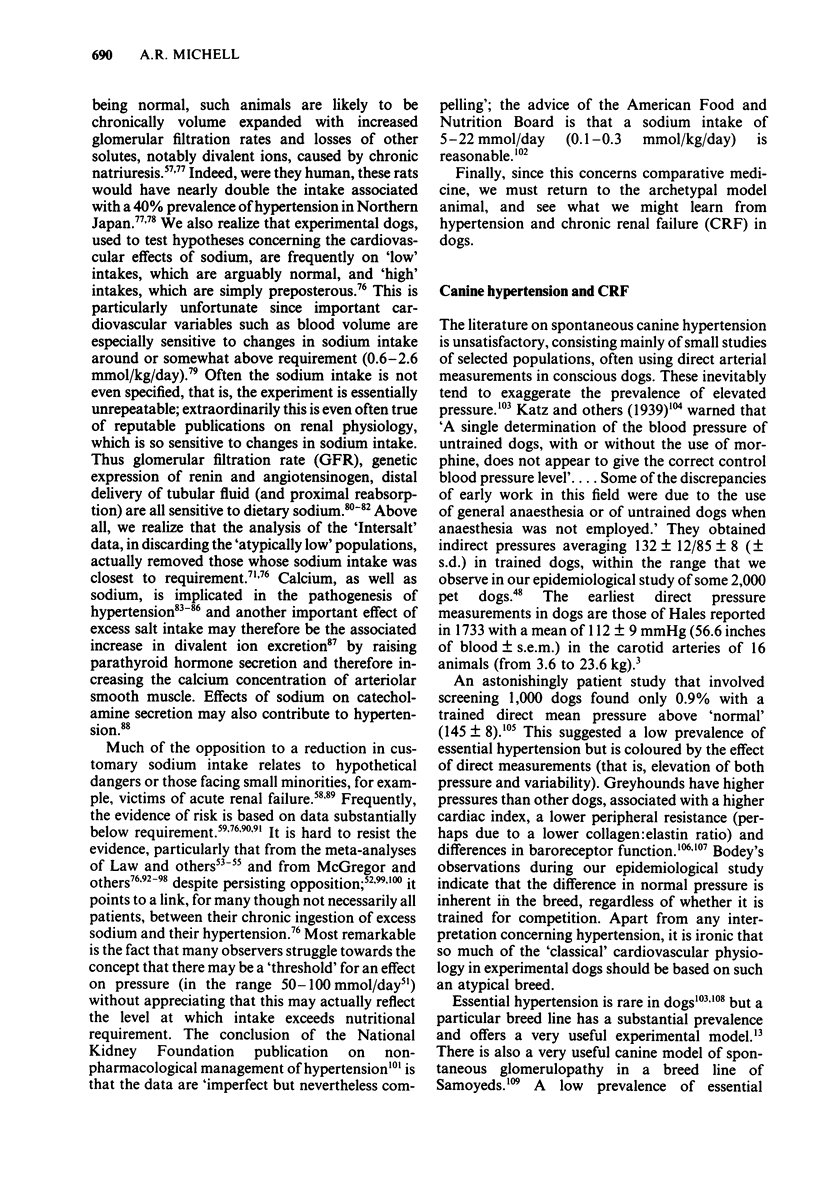
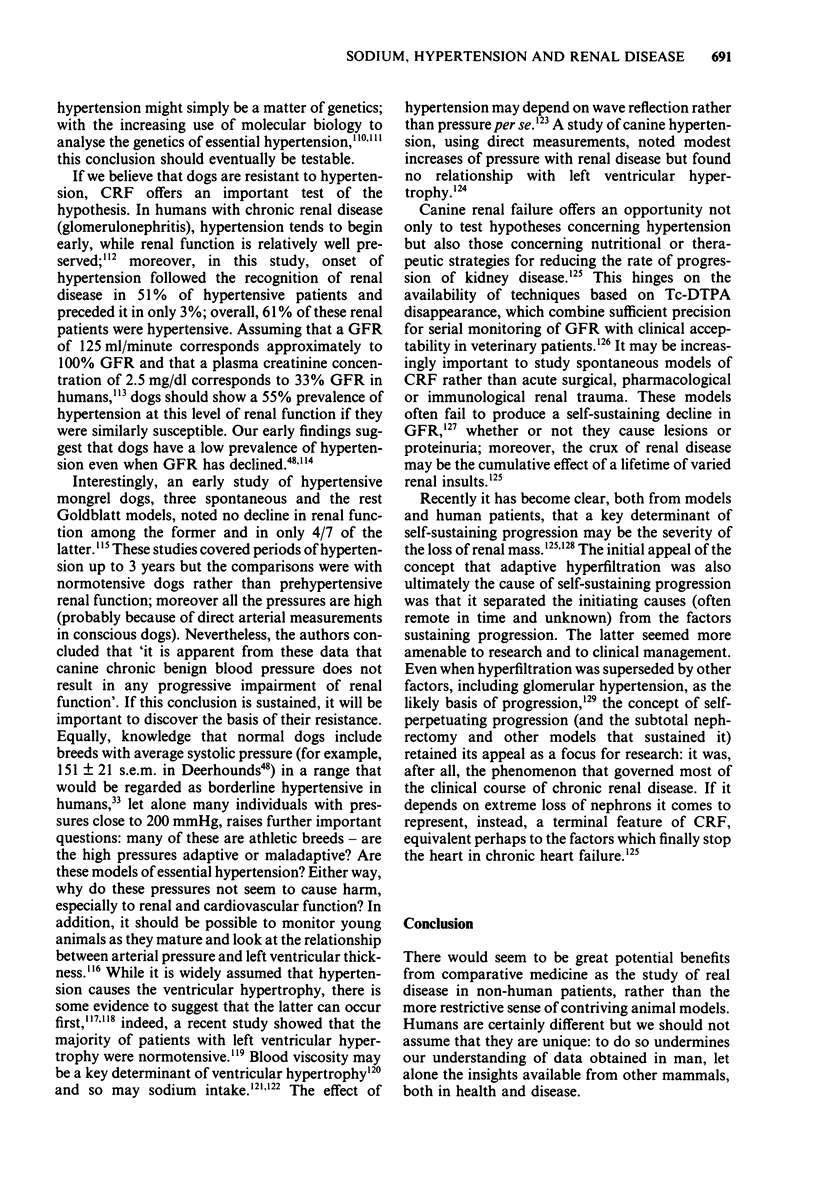
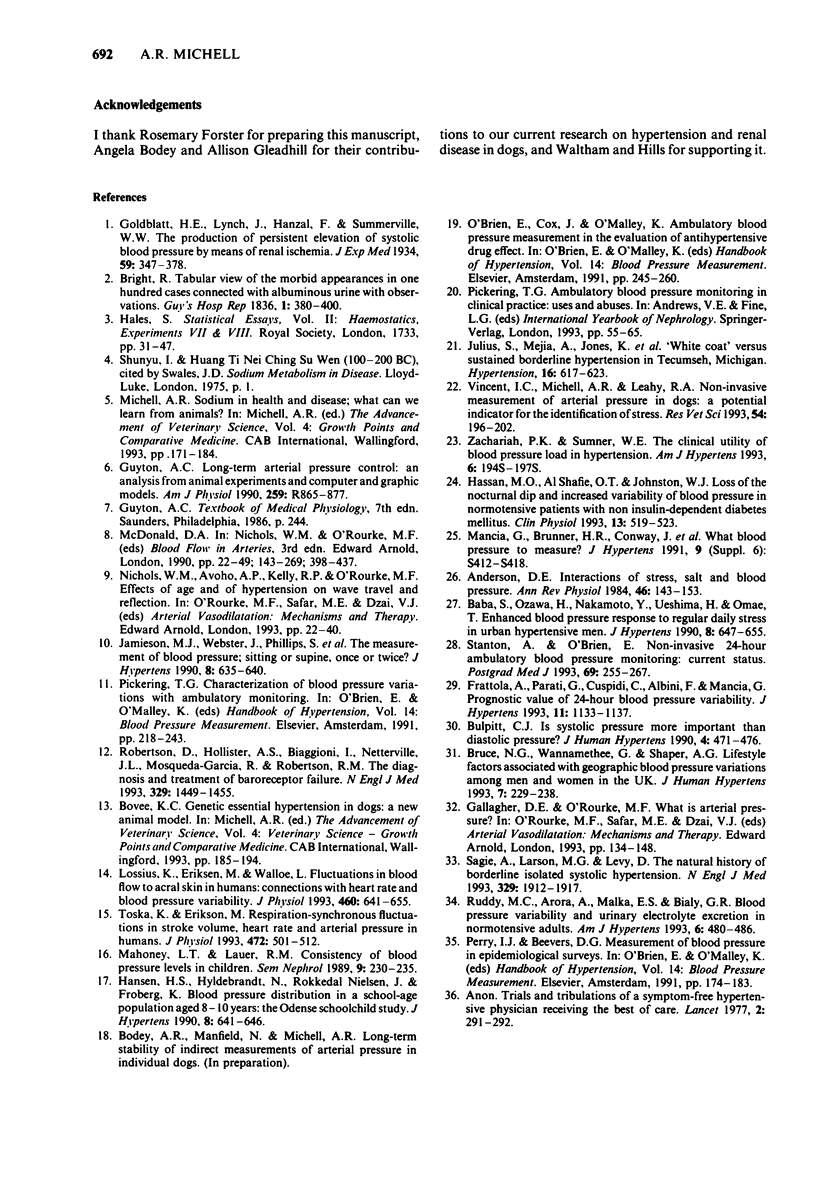

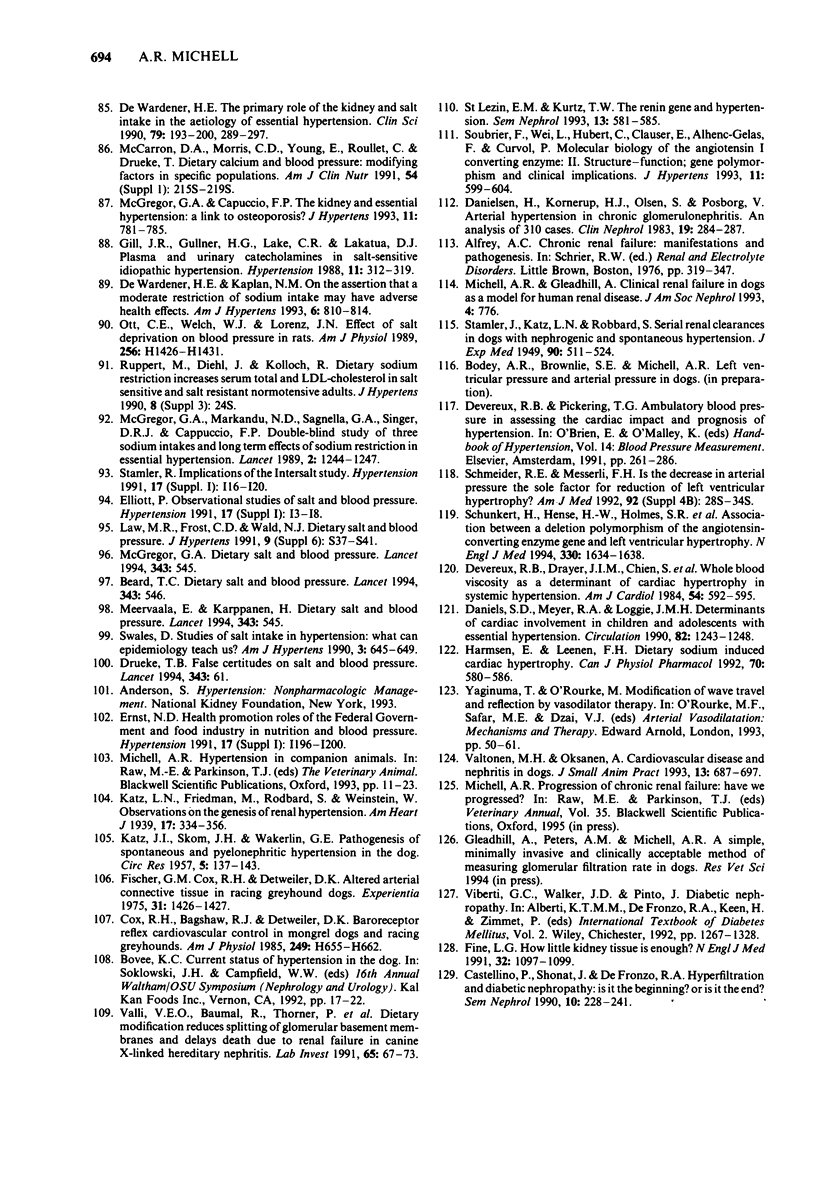
Selected References
These references are in PubMed. This may not be the complete list of references from this article.
- Anderson D. E. Interactions of stress, salt, and blood pressure. Annu Rev Physiol. 1984;46:143–153. doi: 10.1146/annurev.ph.46.030184.001043. [DOI] [PubMed] [Google Scholar]
- Baba S., Ozawa H., Nakamoto Y., Ueshima H., Omae T. Enhanced blood pressure response to regular daily stress in urban hypertensive men. J Hypertens. 1990 Jul;8(7):647–655. doi: 10.1097/00004872-199007000-00008. [DOI] [PubMed] [Google Scholar]
- Beard T. C. A salt-hypertension hypothesis. J Cardiovasc Pharmacol. 1990;16 (Suppl 7):S35–S38. [PubMed] [Google Scholar]
- Beard T. C. Dietary salt and blood pressure. Lancet. 1994 Feb 26;343(8896):546–546. [PubMed] [Google Scholar]
- Beard T. C. Hypertension after Intersalt: prospects for prevention. J Cardiovasc Pharmacol. 1990;16 (Suppl 7):S31–S34. [PubMed] [Google Scholar]
- Benabe J. E., Martinez-Maldonado M. Dietary modification of the renin angiotensin system. Semin Nephrol. 1993 Nov;13(6):567–572. [PubMed] [Google Scholar]
- Blaustein M. P. Sodium ions, calcium ions, blood pressure regulation, and hypertension: a reassessment and a hypothesis. Am J Physiol. 1977 May;232(5):C165–C173. doi: 10.1152/ajpcell.1977.232.5.C165. [DOI] [PubMed] [Google Scholar]
- Brown S. A., Walton C. L., Crawford P., Bakris G. L. Long-term effects of antihypertensive regimens on renal hemodynamics and proteinuria. Kidney Int. 1993 Jun;43(6):1210–1218. doi: 10.1038/ki.1993.171. [DOI] [PubMed] [Google Scholar]
- Bruce N. G., Wannamethee G., Shaper A. G. Lifestyle factors associated with geographic blood pressure variations among men and women in the UK. J Hum Hypertens. 1993 Jun;7(3):229–238. [PubMed] [Google Scholar]
- Bulpitt C. J. Is systolic pressure more important than diastolic pressure? J Hum Hypertens. 1990 Oct;4(5):471–476. [PubMed] [Google Scholar]
- Castellino P., Shohat J., DeFronzo R. A. Hyperfiltration and diabetic nephropathy: is it the beginning? Or is it the end? Semin Nephrol. 1990 May;10(3):228–241. [PubMed] [Google Scholar]
- Contreras R. J. Differences in perinatal NaCl exposure alters blood pressure levels of adult rats. Am J Physiol. 1989 Jan;256(1 Pt 2):R70–R77. doi: 10.1152/ajpregu.1989.256.1.R70. [DOI] [PubMed] [Google Scholar]
- Cox R. H., Bagshaw R. J., Detweiler D. K. Baroreceptor reflex cardiovascular control in mongrel dogs and racing greyhounds. Am J Physiol. 1985 Sep;249(3 Pt 2):H655–H662. doi: 10.1152/ajpheart.1985.249.3.H655. [DOI] [PubMed] [Google Scholar]
- Dahl L. K. Salt and hypertension. Am J Clin Nutr. 1972 Feb;25(2):231–244. doi: 10.1093/ajcn/25.2.231. [DOI] [PubMed] [Google Scholar]
- Daniels S. D., Meyer R. A., Loggie J. M. Determinants of cardiac involvement in children and adolescents with essential hypertension. Circulation. 1990 Oct;82(4):1243–1248. doi: 10.1161/01.cir.82.4.1243. [DOI] [PubMed] [Google Scholar]
- Danielsen H., Kornerup H. J., Olsen S., Posborg V. Arterial hypertension in chronic glomerulonephritis. An analysis of 310 cases. Clin Nephrol. 1983 Jun;19(6):284–287. [PubMed] [Google Scholar]
- Devereux R. B., Drayer J. I., Chien S., Pickering T. G., Letcher R. L., DeYoung J. L., Sealey J. E., Laragh J. H. Whole blood viscosity as a determinant of cardiac hypertrophy in systemic hypertension. Am J Cardiol. 1984 Sep 1;54(6):592–595. doi: 10.1016/0002-9149(84)90255-8. [DOI] [PubMed] [Google Scholar]
- Drüeke T. B. False certitude on salt and blood pressure. Lancet. 1994 Jan 1;343(8888):61–61. doi: 10.1016/s0140-6736(94)90919-9. [DOI] [PubMed] [Google Scholar]
- Ernst N. D. Health promotion roles of the federal government and food industry in nutrition and blood pressure. Hypertension. 1991 Jan;17(1 Suppl):I196–I200. doi: 10.1161/01.hyp.17.1_suppl.i196. [DOI] [PubMed] [Google Scholar]
- Fine L. G. How little kidney tissue is enough? N Engl J Med. 1991 Oct 10;325(15):1097–1099. doi: 10.1056/NEJM199110103251509. [DOI] [PubMed] [Google Scholar]
- Fischer G. M., Cox R. H., Detweiler D. K. Altered arterial connective tissue in racing greyhound dogs. Experientia. 1975 Dec 15;31(12):1426–1427. doi: 10.1007/BF01923225. [DOI] [PubMed] [Google Scholar]
- Frattola A., Parati G., Cuspidi C., Albini F., Mancia G. Prognostic value of 24-hour blood pressure variability. J Hypertens. 1993 Oct;11(10):1133–1137. doi: 10.1097/00004872-199310000-00019. [DOI] [PubMed] [Google Scholar]
- Gill J. R., Jr, Güllner G., Lake C. R., Lakatua D. J., Lan G. Plasma and urinary catecholamines in salt-sensitive idiopathic hypertension. Hypertension. 1988 Apr;11(4):312–319. doi: 10.1161/01.hyp.11.4.312. [DOI] [PubMed] [Google Scholar]
- Goldblatt H., Lynch J., Hanzal R. F., Summerville W. W. STUDIES ON EXPERIMENTAL HYPERTENSION : I. THE PRODUCTION OF PERSISTENT ELEVATION OF SYSTOLIC BLOOD PRESSURE BY MEANS OF RENAL ISCHEMIA. J Exp Med. 1934 Feb 28;59(3):347–379. doi: 10.1084/jem.59.3.347. [DOI] [PMC free article] [PubMed] [Google Scholar]
- Granger J. P., West D., Scott J. Abnormal pressure natriuresis in the dog model of obesity-induced hypertension. Hypertension. 1994 Jan;23(1 Suppl):I8–11. doi: 10.1161/01.hyp.23.1_suppl.i8. [DOI] [PubMed] [Google Scholar]
- Guyton A. C. Long-term arterial pressure control: an analysis from animal experiments and computer and graphic models. Am J Physiol. 1990 Nov;259(5 Pt 2):R865–R877. doi: 10.1152/ajpregu.1990.259.5.R865. [DOI] [PubMed] [Google Scholar]
- Hansen H. S., Hyldebrandt N., Nielsen J. R., Froberg K. Blood pressure distribution in a school-age population aged 8-10 years: the Odense Schoolchild Study. J Hypertens. 1990 Jul;8(7):641–646. doi: 10.1097/00004872-199007000-00007. [DOI] [PubMed] [Google Scholar]
- Harmsen E., Leenen F. H. Dietary sodium induced cardiac hypertrophy. Can J Physiol Pharmacol. 1992 Apr;70(4):580–586. doi: 10.1139/y92-073. [DOI] [PubMed] [Google Scholar]
- Hassan M. O., al Shafie O. T., Johnston W. J. Loss of the nocturnal dip and increased variability of blood pressure in normotensive patients with noninsulin-dependent diabetes mellitus. Clin Physiol. 1993 Sep;13(5):519–523. doi: 10.1111/j.1475-097x.1993.tb00467.x. [DOI] [PubMed] [Google Scholar]
- Hilden T. The influence of arterial compliance on diastolic blood pressure and its relation to cardiovascular events. J Hum Hypertens. 1991 Jun;5(3):131–135. [PubMed] [Google Scholar]
- Jamieson M. J., Webster J., Philips S., Jeffers T. A., Scott A. K., Robb O. J., Lovell H. G., Petrie J. C. The measurement of blood pressure: sitting or supine, once or twice? J Hypertens. 1990 Jul;8(7):635–640. doi: 10.1097/00004872-199007000-00006. [DOI] [PubMed] [Google Scholar]
- KATZ J. I., SKOM J. H., WAKERLIN G. E. Pathogenesis of spontaneous and pyelonephritic hypertension in the dog. Circ Res. 1957 Mar;5(2):137–143. doi: 10.1161/01.res.5.2.137. [DOI] [PubMed] [Google Scholar]
- Kern T. S., Engerman R. L. Arrest of glomerulopathy in diabetic dogs by improved glycaemic control. Diabetologia. 1990 Sep;33(9):522–525. doi: 10.1007/BF00404138. [DOI] [PubMed] [Google Scholar]
- Kirsch M., Reusch C. Urinbefunde bei Hunden mit Diabetes mellitus. Gibt es eine diabetische Nephropathie beim Hund? Tierarztl Prax. 1993 Aug;21(4):345–348. [PubMed] [Google Scholar]
- Law M. R., Frost C. D., Wald N. J. By how much does dietary salt reduction lower blood pressure? I--Analysis of observational data among populations. BMJ. 1991 Apr 6;302(6780):811–815. doi: 10.1136/bmj.302.6780.811. [DOI] [PMC free article] [PubMed] [Google Scholar]
- Law M. R., Frost C. D., Wald N. J. By how much does dietary salt reduction lower blood pressure? III--Analysis of data from trials of salt reduction. BMJ. 1991 Apr 6;302(6780):819–824. doi: 10.1136/bmj.302.6780.819. [DOI] [PMC free article] [PubMed] [Google Scholar]
- Lossius K., Eriksen M., Walløe L. Fluctuations in blood flow to acral skin in humans: connection with heart rate and blood pressure variability. J Physiol. 1993 Jan;460:641–655. doi: 10.1113/jphysiol.1993.sp019491. [DOI] [PMC free article] [PubMed] [Google Scholar]
- MacGregor G. A., Markandu N. D., Sagnella G. A., Singer D. R., Cappuccio F. P. Double-blind study of three sodium intakes and long-term effects of sodium restriction in essential hypertension. Lancet. 1989 Nov 25;2(8674):1244–1247. doi: 10.1016/s0140-6736(89)91852-7. [DOI] [PubMed] [Google Scholar]
- Mahoney L. T., Lauer R. M. Consistency of blood pressure levels in children. Semin Nephrol. 1989 Sep;9(3):230–235. [PubMed] [Google Scholar]
- Mancia G., Brunner H. R., Conway J., O'Brien E., Pessina A. C., Staessen J., Zanchetti A. Round Table: What blood pressure to measure? J Hypertens Suppl. 1991 Dec;9(6):S412–S418. [PubMed] [Google Scholar]
- McCarron D. A., Morris C. D., Young E., Roullet C., Drüeke T. Dietary calcium and blood pressure: modifying factors in specific populations. Am J Clin Nutr. 1991 Jul;54(1 Suppl):215S–219S. doi: 10.1093/ajcn/54.1.215S. [DOI] [PubMed] [Google Scholar]
- Mervaala E., Karppanen H. Dietary salt and blood pressure. Lancet. 1994 Feb 26;343(8896):545–546. [PubMed] [Google Scholar]
- Michell A. R. Salt and hypertension. Lancet. 1980 Jun 21;1(8182):1358–1358. [PubMed] [Google Scholar]
- Michell A. R. Salt appetite, salt intake, and hypertension: a deviation of perspective. Perspect Biol Med. 1978 Spring;21(3):335–347. doi: 10.1353/pbm.1978.0006. [DOI] [PubMed] [Google Scholar]
- Nicolantonio R. D., Spargo S., Morgan T. O. Prenatal high salt diet increases blood pressure and salt retention in the spontaneously hypertensive rat. Clin Exp Pharmacol Physiol. 1987 Mar;14(3):233–235. doi: 10.1111/j.1440-1681.1987.tb00381.x. [DOI] [PubMed] [Google Scholar]
- Norton S. A. Salt consumption in ancient Polynesia. Perspect Biol Med. 1992 Winter;35(2):160–181. doi: 10.1353/pbm.1992.0016. [DOI] [PubMed] [Google Scholar]
- Ott C. E., Welch W. J., Lorenz J. N., Whitescarver S. A., Kotchen T. A. Effect of salt deprivation on blood pressure in rats. Am J Physiol. 1989 May;256(5 Pt 2):H1426–H1431. doi: 10.1152/ajpheart.1989.256.5.H1426. [DOI] [PubMed] [Google Scholar]
- Robertson D., Hollister A. S., Biaggioni I., Netterville J. L., Mosqueda-Garcia R., Robertson R. M. The diagnosis and treatment of baroreflex failure. N Engl J Med. 1993 Nov 11;329(20):1449–1455. doi: 10.1056/NEJM199311113292003. [DOI] [PubMed] [Google Scholar]
- Ruddy M. C., Arora A., Malka E. S., Bialy G. B. Blood pressure variability and urinary electrolyte excretion in normotensive adults. Am J Hypertens. 1993 Jun;6(6 Pt 1):480–486. doi: 10.1093/ajh/6.6.480. [DOI] [PubMed] [Google Scholar]
- STAMLER J., KATZ L. N., RODBARD S. Serial renal clearances in dogs with nephrogenic and spontaneous hypertension. J Exp Med. 1949 Dec;90(6):511-24, 2 pl. doi: 10.1084/jem.90.6.511. [DOI] [PMC free article] [PubMed] [Google Scholar]
- Sagie A., Larson M. G., Levy D. The natural history of borderline isolated systolic hypertension. N Engl J Med. 1993 Dec 23;329(26):1912–1917. doi: 10.1056/NEJM199312233292602. [DOI] [PubMed] [Google Scholar]
- Sanchez-Castillo C. P., Warrender S., Whitehead T. P., James W. P. An assessment of the sources of dietary salt in a British population. Clin Sci (Lond) 1987 Jan;72(1):95–102. doi: 10.1042/cs0720095. [DOI] [PubMed] [Google Scholar]
- Schmieder R. E., Messerli F. H. Is the decrease in arterial pressure the sole factor for reduction of left ventricular hypertrophy? Am J Med. 1992 Apr 27;92(4B):28S–34S. doi: 10.1016/0002-9343(92)90144-z. [DOI] [PubMed] [Google Scholar]
- Schunkert H., Hense H. W., Holmer S. R., Stender M., Perz S., Keil U., Lorell B. H., Riegger G. A. Association between a deletion polymorphism of the angiotensin-converting-enzyme gene and left ventricular hypertrophy. N Engl J Med. 1994 Jun 9;330(23):1634–1638. doi: 10.1056/NEJM199406093302302. [DOI] [PubMed] [Google Scholar]
- Schwan A., Jonsson D. Short-term variation in blood pressure determines the accuracy of simultaneous and sequential recordings in the validation of blood pressure measuring devices. J Hum Hypertens. 1993 Aug;7(4):315–319. [PubMed] [Google Scholar]
- Soubrier F., Wei L., Hubert C., Clauser E., Alhenc-Gelas F., Corvol P. Molecular biology of the angiotensin I converting enzyme: II. Structure-function. Gene polymorphism and clinical implications. J Hypertens. 1993 Jun;11(6):599–604. doi: 10.1097/00004872-199306000-00003. [DOI] [PubMed] [Google Scholar]
- St Lezin E. M., Kurtz T. W. The renin gene and hypertension. Semin Nephrol. 1993 Nov;13(6):581–585. [PubMed] [Google Scholar]
- Stamler J. Dietary salt and blood pressure. Ann N Y Acad Sci. 1993 Mar 15;676:122–156. doi: 10.1111/j.1749-6632.1993.tb38730.x. [DOI] [PubMed] [Google Scholar]
- Stamler R., Liu L. S., Nichols R., Huang D. X., Long Z. P., Xie J. X., Elliott P. Blood pressure and life style in the People's Republic of China: three samples in the INTERSALT Study. J Hum Hypertens. 1993 Oct;7(5):429–435. [PubMed] [Google Scholar]
- Stanton A., O'Brien E. Noninvasive 24 hour ambulatory blood pressure monitoring: current status. Postgrad Med J. 1993 Apr;69(810):255–267. doi: 10.1136/pgmj.69.810.255. [DOI] [PMC free article] [PubMed] [Google Scholar]
- Swales J. D. Studies of salt intake in hypertension. What can epidemiology teach us? Am J Hypertens. 1990 Aug;3(8 Pt 1):645–649. doi: 10.1093/ajh/3.8.645. [DOI] [PubMed] [Google Scholar]
- Toska K., Eriksen M. Respiration-synchronous fluctuations in stroke volume, heart rate and arterial pressure in humans. J Physiol. 1993 Dec;472:501–512. doi: 10.1113/jphysiol.1993.sp019958. [DOI] [PMC free article] [PubMed] [Google Scholar]
- Valli V. E., Baumal R., Thorner P., Jacobs R., Marrano P., Davies C., Qizilbash B., Clarke H. Dietary modification reduces splitting of glomerular basement membranes and delays death due to renal failure in canine X-linked hereditary nephritis. Lab Invest. 1991 Jul;65(1):67–73. [PubMed] [Google Scholar]
- Valtonen M. H., Oksanen A. Cardiovascular disease and nephritis in dogs. J Small Anim Pract. 1972 Dec;13(12):687–697. doi: 10.1111/j.1748-5827.1972.tb06823.x. [DOI] [PubMed] [Google Scholar]
- Whiteside C., Katz A., Cho C., Silverman M. Diabetic glomerulopathy following unilateral nephrectomy in the dog. Clin Invest Med. 1990 Oct;13(5):279–286. [PubMed] [Google Scholar]
- Zachariah P. K., Sumner W. E., 3rd The clinical utility of blood pressure load in hypertension. Am J Hypertens. 1993 Jun;6(6 Pt 2):194S–197S. [PubMed] [Google Scholar]
- de Wardener H. E., Kaplan N. M. On the assertion that a moderate restriction of sodium intake may have adverse health effects. Am J Hypertens. 1993 Sep;6(9):810–814. doi: 10.1093/ajh/6.9.810. [DOI] [PubMed] [Google Scholar]
- de Wardener H. E. The primary role of the kidney and salt intake in the aetiology of essential hypertension: Part II. Clin Sci (Lond) 1990 Oct;79(4):289–297. doi: 10.1042/cs0790289. [DOI] [PubMed] [Google Scholar]
- del Castillo E., Fuenzalida R., Uranga J. Increased glomerular filtration rate and glomerulopressin activity in diabetic dogs. Horm Metab Res. 1977 Jan;9(1):46–53. doi: 10.1055/s-0028-1093582. [DOI] [PubMed] [Google Scholar]


